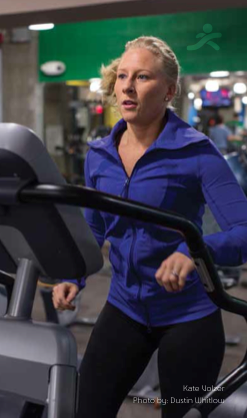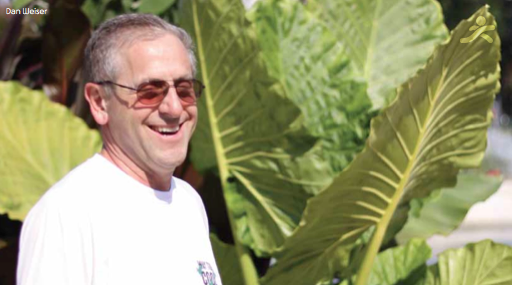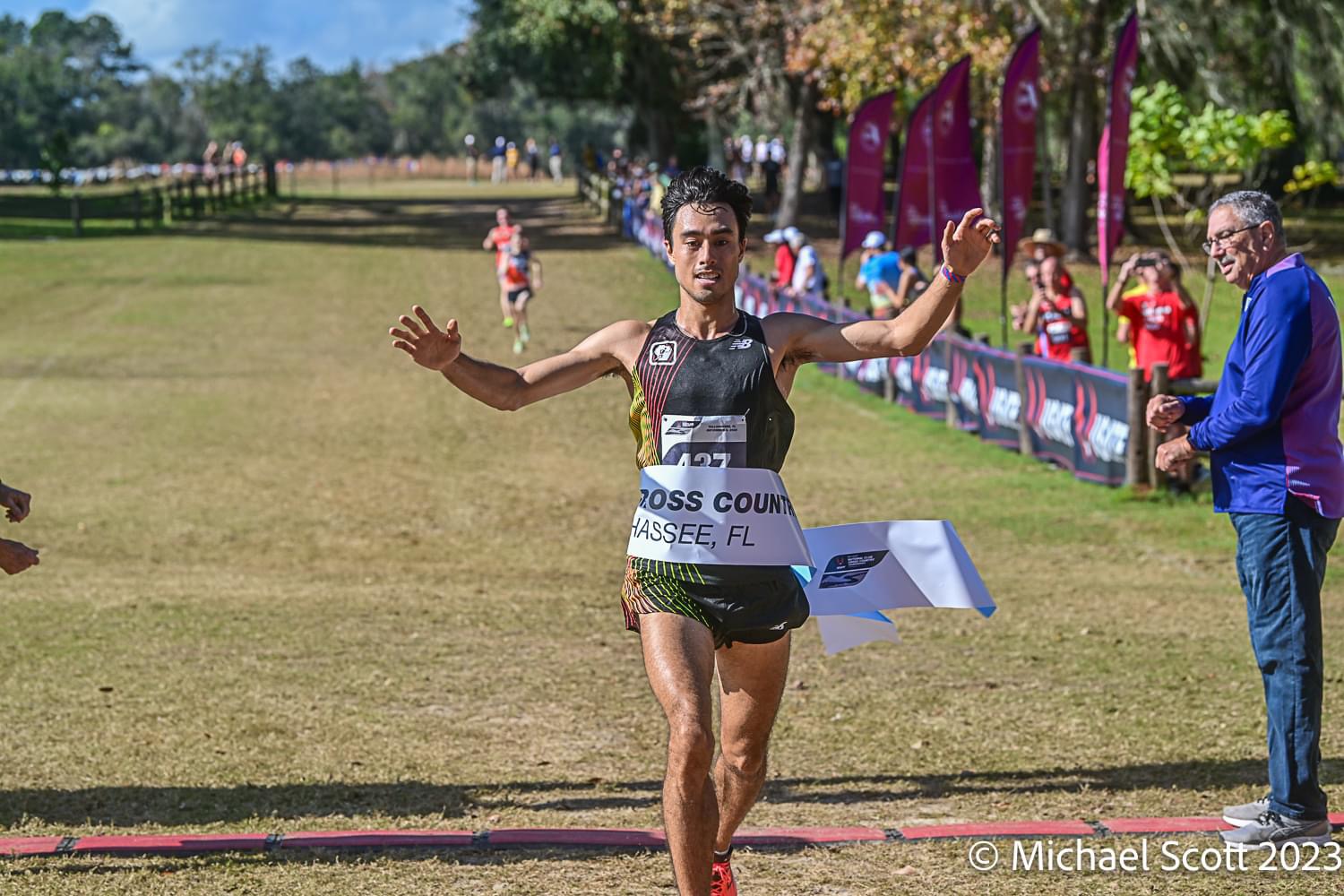
Everything is supposed to hurt during a marathon.
Right?
That’s what Kate Volzer told herself in Philadelphia. Her legs were tired, back was sore, hip ached, but it all seemed like a temporary price to pay for the race she was running, the race of her life.
“My hip had been hurting for a month, but given the mileage I was running, it made sense something would be nagging,” she said.

All of those miles paid off — she brought a 2:53 home to Arlington and enjoyed a few days off before she rejoined her GRC Racing teammates and Potomac Runners. But when she headed out the door to run again, she greeted a pain far worse than she had felt in the city of brotherly love.
Her physical therapist assured her it was a hamstring injury, at worst a tear, and it would heal with rest. A few doctors said that. For months, she followed the frustrating cycle of testing and resting, finding herself an unwitting initiate of a large distance running fraternity. The injured. Delta-Ow-Docta.
It starts with change. Something more than the body is ready to handle. Too much new mileage, too many work- outs, trusting too blindly in faddy running shoes. The averages say it’s going to catch up with everyone eventually, everyone who pushes themselves to get faster. Sometimes a mild injury in one place can cause a form change that has musculoskeletal repercussions, like the plantar fascitis that help fell the erstwhile indestructible Michael Wardian.
He was absent from race results for the first time in more than 10 years in 2012. After thousands upon thousands of miles, his body didn’t have an answer, and in August he was sidelined with five pelvic stress fractures. “The longest I’ve ever taken off was a day here or there when I’m traveling,” he said. “It feels like something’s missing.“
Perhaps it’s the 110 miles a week, or the ability to run the Houston Marathon the morning after competing in the U.S. Olympic Marathon Trials since he was already in town.
He attributes some of his injury to lack of sleep, because he and his wife take turns watching their son, Grant, who has recently suffered from seizures, which are under control now. With more rest and recovery, he hopes to be running in late October or early November. Though he targets the Kansas City North Face Endurance Challenge, he’ll be happy to race the local Kinhaven 5k, which benefits his sons’ school.

In the meantime, he bikes, including a one-day trip down Skyline Drive, to keep himself in shape. He’s not exactly sitting on the couch watching television.
“Now I feel like I’m a real runner,” he said. “Everyone else I know has dealt with an injury. I’m putting my time in. This is a blip on the radar.”
“Every time I’d go out for a run, I’d cross my fingers and say ‘please don’t hurt, please don’t hurt…’”
Doctors advised Volzer to find a new sport, take a corti- sone shot or elect for surgery, but it was too early for her to go under the knife. She took total rest for a few weeks and gave it another shot.
No dice. This time, her right hip joined in.
Her doctor suggested the body’s symmetry was too uncanny to ignore. Further testing confirmed that her right labrum was also torn.
“I had already made the decision to go with surgery on the left hip, so by this point I figured I might as well take care of everything, rather than start up again and be forced to rehabilitate all over again.”
So she was sliced up twice in August — left, then right, for each labrum to be repaired and irritating bone to be shaved down. She’s looking at a late November return to running. In the meantime, though, she faces some existential questions.
“When you are at a certain level of running and then you can’t run due to injury, you tend to feel like you are no longer an elite runner because you aren’t technically running,” she said. “So if you aren’t the elite runner that you were and so badly want to be again, who are you? Who am I when I am injured? Am I still a runner?”
Liz Greenlaw’s body has given her almost two years’ worth of reasons to stop running.
Riding high on a string of great races in early 2011, she was looking ahead to that fall’s Marine Corps Marathon. A stress fracture took her out, and she discovered she, like Volzer, had torn a labrum and would need surgery. She recovered from her fall 2011 procedure and gingerly ran again in the spring, gaining confidence in fun races, running under a family alias. She was primed for Marine Corps, and her fitness was coming along, until she felt her pelvis shift during a Capital Area Runners workout. She took time off and tried again to run for an hour in August. Afterward she knew she had to beg down to the 10k. Now, with another stress fracture diagnosed, she can just wait and start over.
But she will start over. She saw the course toward her potential with some great races and knew that wasn’t “it.” “I have total confidence I can get back to that,” she said. “There’s more running for me to do.”
She keeps her age group award from the 2009 Marine Corps race framed above her bedroom door so she sees a reminder of better times whenever she walks out
“I remember how it felt to run healthy. I miss the adrenaline. I replay old races in my head, tough, challenging ones that ended up to be rewarding.”
When Keith Kauffman works with injured runners, he keeps them focused on the present.
“There’s a temptation to get caught in the past or the future,” he said. “The regret, the what ifs. Athletes aren’t the best at staying patient.”
He’s a sports psychologist with offices in Alexandria and Washington who also works with Catholic University’s sport psychology research lab.“Confidence is a tenuous thing when your body fails you,” he said. “There’s the fear of re-injury, concerns about lost fitness and the motivation to try and do too much when they get back.”
He said many injured runners show depressive symptoms, in part because of their separation from their ex- ercise outlet, but more because they are missing out on what they enjoy, which includes social time for many. As a result, injuries can be harder on high school athletes. “Their teams are often their primary social group,” Kaufman said. “Injured time is time away from their friends and less attention from their coach.”
College student-athletes carry the added complication of losing a scholarship when mental burnout and extended injury lead them to walk away. Post-collegiate runners, though, face different concerns, especially as they age.
“I think knowing and being able to accept when a window has closed are potentially huge challenges for athletes, particularly when their identities have long been tied to their sport,” he said. “This is why an injury that is career-threatening could be so devastating,” because they have to face the limitations that their body puts on them. “They may be left with an unsettling feeling of, ‘what now?’”
Runners aren’t doomed to lives of injury and frustration, though. Through all the discipline and routine rehab, there’s some hope. Dan Weiser took his first significant run in five months on Sept. 23, 2012. His poorly-aligned kneecaps deteriorated to the point where running was out of the question and climbing stairs or even hopping over curbs was a problem. He didn’t deal with a draconian physician, though.
“My surgeon (John Klimkiewicz) never says ‘don’t run,’ but always works with me to find ways to keep active,” he said.
Weiser races a range of distances from 400 meters to 50k. Variety is not as enticing if he isn’t wearing the rubber off of his shoes.
“Weights, stretching and swimming don’t do it for me,” he said, noting that biking also hurts his knees. “I miss the camaraderie of other runners.”
As a coordinator for DC Capital Striders’ evening Mall runs, he remains at the center of activity for the popular group runs. Now, he’s on his way back.
His physical therapist, Alan Brodnick, had him try alternating walking and light running for a minute at at a time. He increased it slowly, held back when necessary.
“I felt great and wanted to keep running, especially as other runners passed me,” he said. “I wanted to end the run feeling great, not in any pain, so that was my motivation for staying at five minutes.”
Lindsay Wilkins couldn’t do any cross training when she was hurt. In spring 2009, she tripped and tore the ham- string away from her right “sit bone.” It wasn’t something doctors normally saw in runners; rather, it was more of a hockey or water skiing injury. For six weeks, she was trapped in a hip cast. She could stand and lie down. No sitting. And certainly no Pacers racing team workouts. Traveling meant lying in her hatchback as her husband Brian drove her to doctor’s appointments.
“It was a very difficult adjustment, but that surgery was the only way I’d be able to run competitively again,” she said. Removing the cast at the end of six weeks was liberating, but the atrophy in her leg forced her to re-learn how to walk. Her subsequent stab at running was gradual.
“It was like I had never run a step in my life,” she said. After more than a year, she felt something click. Unlike the well-documented fracturing of a bone or snap of a tendon, instead she felt like a runner again, the kind who was once 10 seconds away from winning a marathon two years prior. She was back, and it was time to see what “back” meant.
Her shot at the 2011 Chicago Marathon said it all. On a day much warmer than her 2008 Marine Corps runner up, she finished a mere minute off of her PR.
The whole process made her much more mentally tough.
“Feeling bad in a race is nothing compared to the misery of not being able to run,” she said.
Volzer has been careful in the weeks following surgery. She’s taking her rehab seriously and her cross training lightly.“My personality is a little pessimistic,” she said. “I’m always worrying about worst-case scenarios, and I’ve wondered at times what I will do if I start running again and the surgeries didn’t fix anything.”
She said even as the months piled on without an answer, she never gave up on running.
“I never lost hope, I got upset when I had a setback, but I never thought I wouldn’t be running again someday.” While she is waiting to resume her old life, Volzer can go to happy hours and meet up with friends after work instead of hitting the track. But that doesn’t mean it’s not on her mind. Or that she doesn’t miss her GRC racing team and Potomac Runners training partners.
“I daydream about when I run again, all the time,” she said. “I don’t care how slow I’ll be, I know I’ll be smiling the whole time.”
Not bad for a self-described pessimist.
This article originally appeared in the November/December 2012 issue of RunWashington.
Recent Stories
Looking for our race calendar? Click here Submit races here or shop local for running gear
James W. Foley Freedom Run
Inspired by the moral courage of freelance journalist James Foley, the mission of the nonprofit Foley Foundation is to secure the freedom of Americans held captive abroad unjustly by terrorist organizations or rogue states, and to promote journalist safety.
The
Kensington 8K Race
Since 1994, the Kensington 8K Race has been a favorite DC area fall race – a fun, fast event with beauty, challenge, and excitement. Run it this year on Saturday, September 21, 2024!
The 8K distance is $39, with a






